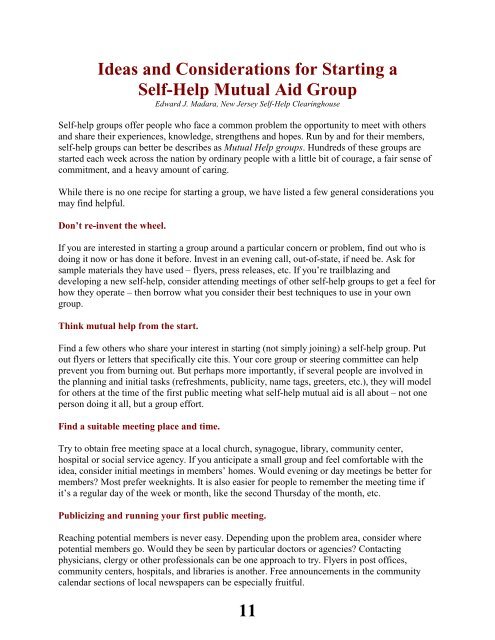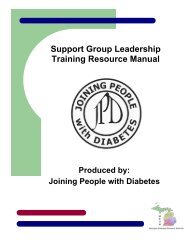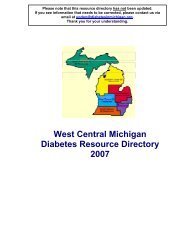Support Group - Michigan Diabetes Outreach Network
Support Group - Michigan Diabetes Outreach Network
Support Group - Michigan Diabetes Outreach Network
Create successful ePaper yourself
Turn your PDF publications into a flip-book with our unique Google optimized e-Paper software.
Ideas and Considerations for Starting a<br />
Self-Help Mutual Aid <strong>Group</strong><br />
Edward J. Madara, New Jersey Self-Help Clearinghouse<br />
Self-help groups offer people who face a common problem the opportunity to meet with others<br />
and share their experiences, knowledge, strengthens and hopes. Run by and for their members,<br />
self-help groups can better be describes as Mutual Help groups. Hundreds of these groups are<br />
started each week across the nation by ordinary people with a little bit of courage, a fair sense of<br />
commitment, and a heavy amount of caring.<br />
While there is no one recipe for starting a group, we have listed a few general considerations you<br />
may find helpful.<br />
Don’t re-invent the wheel.<br />
If you are interested in starting a group around a particular concern or problem, find out who is<br />
doing it now or has done it before. Invest in an evening call, out-of-state, if need be. Ask for<br />
sample materials they have used – flyers, press releases, etc. If you’re trailblazing and<br />
developing a new self-help, consider attending meetings of other self-help groups to get a feel for<br />
how they operate – then borrow what you consider their best techniques to use in your own<br />
group.<br />
Think mutual help from the start.<br />
Find a few others who share your interest in starting (not simply joining) a self-help group. Put<br />
out flyers or letters that specifically cite this. Your core group or steering committee can help<br />
prevent you from burning out. But perhaps more importantly, if several people are involved in<br />
the planning and initial tasks (refreshments, publicity, name tags, greeters, etc.), they will model<br />
for others at the time of the first public meeting what self-help mutual aid is all about – not one<br />
person doing it all, but a group effort.<br />
Find a suitable meeting place and time.<br />
Try to obtain free meeting space at a local church, synagogue, library, community center,<br />
hospital or social service agency. If you anticipate a small group and feel comfortable with the<br />
idea, consider initial meetings in members’ homes. Would evening or day meetings be better for<br />
members? Most prefer weeknights. It is also easier for people to remember the meeting time if<br />
it’s a regular day of the week or month, like the second Thursday of the month, etc.<br />
Publicizing and running your first public meeting.<br />
Reaching potential members is never easy. Depending upon the problem area, consider where<br />
potential members go. Would they be seen by particular doctors or agencies? Contacting<br />
physicians, clergy or other professionals can be one approach to try. Flyers in post offices,<br />
community centers, hospitals, and libraries is another. Free announcements in the community<br />
calendar sections of local newspapers can be especially fruitful.<br />
11





